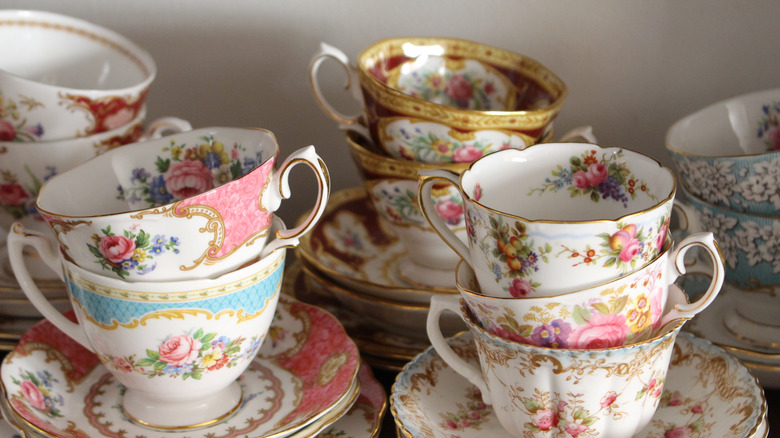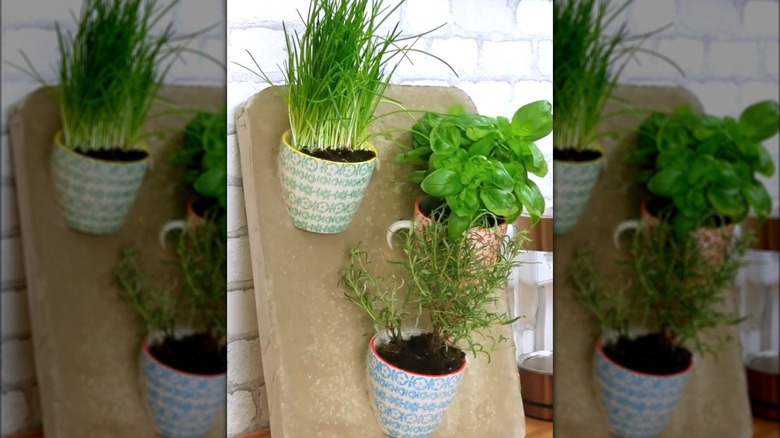Repurpose Old Tea Cups Into A Custom Tiered Planter
We may receive a commission on purchases made from links.
You don't have to be mad or falling down a rabbit hole to love tea cups — in fact, you can find plenty of ways to display thrifted or older cups without turning your home into the Mad Hatter's tea party. Whether you love to collect fun chalices or you have an abundance of porcelain and ceramic mugs you were using as bird feeders that you just can't part with, turning them into a crafty plant holder will solve your conundrums. All you need is a little cement, potted greenery of your choice, and your teacups. Your display will be the envy of all your fellow leaf-lovers, and you can see your favorite chinaware as often as you like rather than leaving it to mold in a cupboard.
With a few simple ingredients and items you probably already own, you can craft a tiered display that provides both vintage chic design and friendly greenery in any room. Upcycling older cups also saves you the money you'd otherwise have to spend on small planters. The result is a personalized exhibit, vibrant with your mug's designs that doesn't require much upkeep at all!
A little cement and a few teacups make amazing artwork
To start, you'll want to choose which teacups you plan to feature in your display. Depending on the size of your mold, you'll need mugs that will fit in the cement block without crowding each other. You can also use a larger mold to create more room for multiple cups, but for a standard silicone rectangle mold, like this one from Amazon for $15, two or three mugs should suffice.
It's important to remember when doing smaller home projects that cement and concrete differ and, therefore, are not meant to be used interchangeably. For a DIY like this mug display, you want to use fast-drying cement like Cement All Multi-Purpose Construction Material from Home Depot for $18. Cement is what you use to bind items together, while concrete is the finished product of cement combined with sand, rock, and other building materials. Cement is an easier mixture for simple in-home projects since it doesn't require the heavier materials mentioned to create a thick, heavy solution that will hold your cups.
Once you've mixed the cement, pour it into the mold and insert your cups while it's still wet so that ¼ to ½ of the porcelain or ceramic is in the mixture. Tier them so each cup will have plenty of space above it for plants to grow. Your teacups should look like they are partially submerged in the cement, and should be standing upright so the plants can sit inside.
Pick blooms or herbs that will thrive in smaller spaces
Make sure to consider water drainage when making this display. Too much water without anywhere to go could drown the plant's nutrients and erode the dirt inside the cup. You can drill a small hole in the bottom of your cup before placing it in the cement, and you may consider adding newspaper inside on the bottom to line the drainage hole. If you want something to catch that water runoff, place half of a saucer you've cut in half in the cement under the cups. Let the cups (and saucers if you add them) dry fully in the cement before removing them from the mold.
From here, you can add your soil and plants to the chinaware before either hanging the whole piece or leaving it propped against a wall on a table, countertop, or other available surface where you plan to keep it. You can choose to create a thriving succulent planter, or use herbs and cacti, which are all great options for your smaller teacups and will thrive without needing too much space. Suppose you prefer your concrete to feature another color other than the standard gray. In that case, you can either paint over it with epoxy or acrylic latex or add cement color to the mixture before pouring it into the mold.

